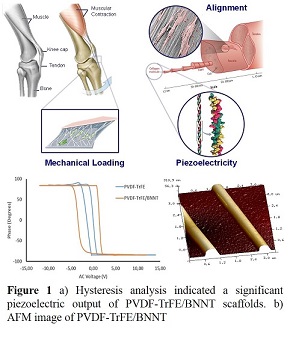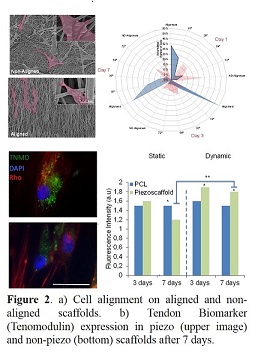Introduction: The design of artificial scaffolds that can recreate the unique physicomechanical features of specific cellular niches is of vital importance for tissue engineering applications. The anisotropic biomechanical properties of tendon tissues are attributed to the high degree of alignment of collagen fibrils, which provides topographical guidance for tenocytes and promote tissue organisation. However, an often overlooked physical property of collagen-rich musculoskeletal tissues is the inherent piezoelectric response to mechanical loading. The conversion of mechanical forces into electrical fields is thought to significantly modulate cell function through transmembrane voltage-gated receptors[1].
In this study, primary human tendon cells were subjected to dynamic tension on a piezoelectric fibrous scaffold developed from poly (vinylidenefluoride-co-trifluoroethylene) P(VDF-TrFE), a material capable of generating electrical charges under mechanical loading with physiological conditions. The sensitivity of the material was further modulated through the incorporation of piezoelectric Boron Nitride nanotubes (BNNTs)[2]. The nanomaterials were evaluated as regenerative scaffolds through the analysis of cellular proliferation and the expression of tendon-specific genes.
Materials and Methods:
P(VDF-TrFE) was dissolved in DMF/Acetone and electrospun into nanoscale fibers. To modulate electrical sensitivity, BNNTs were functionalized with a conductive polymer and incorporated into the matrix. The scaffold morphology was observed by FESEM and the electrical properties in response to cyclic loading were assessed with PFM and an in-house oscilloscope/dynamic loading system. Primary Human Tenocytes were isolated and cultured for 7, 14 and 21 days onto the scaffolds under static and mechanical loading conditions. Samples were, immunoassayed for focal adhesions (FA), Tenomodulin (TNMD), Collagen I (COL-I) and III (COL-III). Gene expression was analyzed using a Custom RT2 Profile PCR array.
Results:

The PDVF-TrFE/BNNT scaffolds were piezoelectric, biocompatible and mechanical stimulation promoted the maintenance of a tenospecific phenotype for up to 21 days. Preliminary results shows that cell morphology and focal adhesion distribution in cells cultured on static and dynamic conditions scaffold were modulated and piezoresponsive gene were upregulated. Despite the findings tat proliferation was lower on piezoscaffolds, tenomodulin expression (transmembrane glycoprotein expressed in Tendon) in piezoelectric nanoscaffolds and tenocyte morphology was maintained after all time points.

Discussion and Conclusions: This study indicates that the piezoelectrical activity of PVDF-TrFE may be tuned by incorporation of BNNTs. Moreover, gene and protein analyses showed that piezoelectric stimulation significantly upregulated the expression of mechanosensitive and voltage gated genes.
Science Foundation Ireland, Starting Investigator SIRG COFUND fellow (grant agreement no. 11/SIRG/B2135); Science Foundation Ireland Centre for Research in Medical Devices (CÚRAM) (Grant agreement no. 13/RC/2073)
References:
[1] Marc A. Fernandez-Yague, Sunny Akogwu Abbah , Laoise McNamara , Dimitrios I. Zeugolis , Abhay Pandit , Manus J. Biggs. Biomimetic Approaches in Bone Tissue Engineering: Integrating Biological and Physicomechanical Strategies. Advanced drug delivey reviews (2015)
[2] Marc A. Fernandez-Yague, Aitor Larrañaga, Olga Gladkovskaya, Alanna Stanley, Ghazal Tadayyon, Yina Guo, Jose-Ramon, Sarasua, Tofail A.M Syed, DimitriosI Zeugolis, Abhay Pandit and Manus J.P Biggs. Effects of Polydopamine Functionalization on Boron Nitride Nanotube Dispersion and Cytocompatibility. Bioconjugate Chemistry (2015)